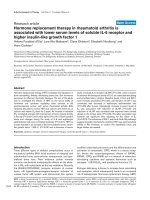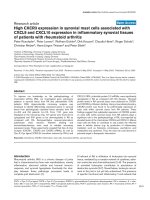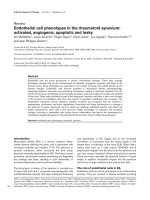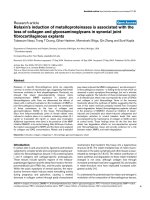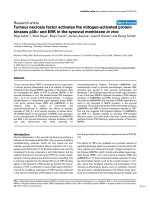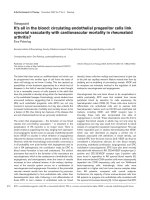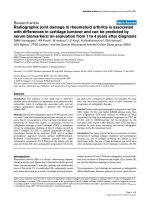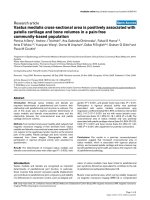Báo cáo y học: "Küttner’s tumor of the sub-mandibular gland associated with fibrosclerosis and follicular hyperplasia of regional lymph nodes: a case report" pdf
Bạn đang xem bản rút gọn của tài liệu. Xem và tải ngay bản đầy đủ của tài liệu tại đây (2.98 MB, 7 trang )
CAS E REP O R T Open Access
Küttner’s tumor of the sub-mandibular gland
associated with fibrosclerosis and follicular
hyperplasia of regional lymph nodes: a case
report
Yumi Mochizuki
1*
, Ken Omura
1
, Kou Kayamori
2
, Kei Sakamoto
2
, Hiroaki Shimamoto
1
and Akira Yamaguchi
2
Abstract
Introduction: Küttner’s tumor is characterized through histology by peri-ductal fibrosis, dense lymphocytic
infiltration with lymphoid follicles, loss of acini, and occasional marked sclerosis of the salivary gland. On occasion,
Küttner’s tumor can be difficult to distinguish from malignant neoplasm.
Case presentation: A 58-year-old Japanese man was referred to our hospital with a three-month history of a
painless swollen mass in the right sub-mandibular region. Histological findings revealed both lymphoid follicles
with reactive germinal centers and variously sized lymphoid follicle-like nodules without definitive germinal centers
or mantle zones. B-cells of similar size and shape occupied the lymphoid follicle-like nodules and stained positive
for B-cell lymphoma. These cells were detected in the polyclonal B-cells by flow cytometric analysis and tested
negative for CD10. Unusual B-cell proliferation was observed, but as there was no definitive evidence of B-cell
lymphoma, the lesion was diagnosed as Küttner’s tumor.
Conclusion: We report on a rare case of Küttner’s tumor associated with fibrosclerosis and atypical lymphoid
hyperplasia in both the sub-mandibular gland and regional lymph nodes. Although more cases need to be
investigated, our findings might be helpful to further studies seeking to clarify the etiology of idiopathic sclerosing
lesions arising in the organs and regional lymph nodes.
Introduction
Küttner’s tumor, or sclerosing sialoadenitis, is character-
ized through histology by peri-ductal fibrosis, dense
lymphocytic infiltration with lymphoid follicles, loss of
the acini and, occasionally, marked sclerosis of the sali-
vary gland [1]. Here w e report a rare case of Küttner’s
tumor of the sub-mandibular gland associated
with regional lymph nodal adenopathy. Histological
examination revealed that the architecture of both the
sub-mandibular gland and lymph nodes showed marked
fibrocollagenous changes and variously sized lymphoid
follicle-like nodules with atypical B-cell proliferations.
Recently, Küttner’s tumor has been regarded as an
immunoglobulin G4 (IgG4) -related idiopathic sclerosing
lesion, a lesion which is frequently associated with regio-
nal lymph nodal adenopathy [2]. However, our case had
no definitive findings of an IgG4-related idiopathic scler-
osing lesion.
The literature reports a few cases of regional lymph
nodal adenopathy in Küttner’ s tumor of the sub-
mandibular gland [3]. However, to the best of our
knowledge, the present case of broad fibrosclerosing and
atypical lymphoid hyperplasia in both the sub-mandibu-
lar gland and regional lymph nodes is very rare. We dis-
cuss the characteristics and differential diagnostic
problems of Küttner’s tumor.
Case presentation
A 58-year-old Japanese man was referred to our hospital
with a three-month history of a painless swollen mass in
his right sub-mandibular region. Physical examination
* Correspondence:
1
Oral and Maxillofacial Surgery, Department of Oral Restitution, Division of
Oral Health Sciences, Graduate School, Tokyo Medical and Dental University,
1-5-45 Yushima, Bunkyo-ku, Tokyo 113-8549, Japan
Full list of author information is available at the end of the article
Mochizuki et al. Journal of Medical Case Reports 2011, 5:121
/>JOURNAL OF MEDICAL
CASE REPORTS
© 2011 Mochizuki et al; licensee BioMed Central Ltd. This is an Open Access article distributed und er the terms of the Creative
Commons Attribution License ( which permits unrestricted use, distribution, and
reproduction in any medium, provided the original work is properly cited.
revealed an elastic hard mass in his right sub-mandibu-
lar gland. The gland was not fixed to adjace nt tissue.
Several enlarged elastic hard movable lymph nodes were
palpable in the region. Salivary flo w from his right sub-
mandibular gland was poor. Our patient had a history
of a recurrent gastric ulcer from 21 years of age. His
laboratory data were in the normal range except for lac-
tate dehydrogenase (214 U/L; normal range: 105-210 U/
L), g-glutamyl transpeptidase (88 U/L; normal range: 11-
80 U/L), triglyceride (199 mg/dL; normal range: 42-168
mg/dL), leucine aminopeptidase (83 U/L; normal range:
19-69 U/L), and serum immunoglobulin (IgG, 924 mg/
dL; normal range: 870-1700 mg/dL). Regarding the mea-
surem ent of the serum IgG sub class, only his IgG4 level
(16.9 mg/dL; normal range: 4.8-105 mg/dL) was evalu-
ated with the consent of our patient. Other serological
data regarding the Ig levels and auto-antibodies were
not evaluated.
Contrast-enhanced computed tomography of the neck
revealed a 2.8 × 2.8 cm homogeneously hyper-dense
enhanced mass in the right side of his neck which inva-
sively extended to the tissue of his sub-mandibular
gland. Several enlarged lymph nodes were enhanced. In
the sub-mandib ular region, magnetic resonance imaging
(MRI) showed a 3.0 × 3.0 × 4.0 cm mass with hypoin-
tensity on fat-saturated T1-weighted images, and hetero-
geneous hyperintensity and mid-hyperintensity on
gadolinium-enhanced and fat-saturated T2-weighted
images, respectively (Figure 1). Positron emission tomo-
graphy showed an area of high uptake in the same
region. No other uptake lesions were detected. The clin-
ical and radiological appearance suggested a diagnosis of
malignant neoplasms of the sub-mandibular gland and
metastati c spread from a malignant tumor. Reactive fol-
licular hyperplasia was found on an excisional lymph
node biopsy at level II. CD45 gating for routine flow
cytometric an alysis revealed 40.1% and 27.1% of kappa
and lambda light chain expressing cells, respectively.
His right sub-mandibular gland was completely
excised alo ng with lymph nodes in the sub-mandibular
region. Our patient h as been well and there have been
no marked changes in his cond ition at 16 months post-
operatively.
Pathological and immunohistological findings The sub-
mandibular gland: The cut surface of th e surgical speci-
men showed a solid, y ellowish tumor occupying the
sub-mandibular gland space (Figure 2). At low magnifi-
cation, marked parenchymal loss with severe fibrocolla-
genous changes and numerous inflammatory cells were
noted (Figure 3). At higher magnification, scattered lym-
phocytes , eosi nophils and plasma cells were observ ed in
the peri-ductal fibrosis area (Figure 4). A few foreign
body cells were noted in necrotic tissue (Figure 5). No
EBER-positive cells were seen, and no acid-fast bacilli
were detected by Ziehl-Neelsen staining. No lympho-
epithelial lesions were detected. In the fibrosis area,
small and large-sized lymphoid follicle-like nodular
lymphocytic proliferations were observed (Figure 6). Par-
affin-embedded tissue sections, fixed in formalin, were
Figure 1 Fat-saturated T2-weighted weighted MRI. Fat-saturated
T2-weighted weighted MRI showing a heterogeneous hyperintense
mass with indistinct margins between the sub-mandibular gland
and the lymph nodes. The mass extended invasively to the outer
adjacent tissue of the sub-mandibular gland. The sub-mandibular
lymph nodes were hyperintense.
Figure 2 Photograph of the cut surface of the sub-mandibula r
gland. Photograph of the cut surface of the sub-mandibular gland.
The sub-mandibular gland space was occupied solid, yellow-wish
substances.
Mochizuki et al. Journal of Medical Case Reports 2011, 5:121
/>Page 2 of 7
stained with the antibodies listed in Table 1. An lmmu-
nohistochemical study revealed that the lymphoid folli-
cle-like nodular lesions were occupied by small round to
oval shaped lymphocytes. These cells tested positive for
CD20 and Bcl-2 (Figure 7, Figure 8, Figure 9), and nega-
tive for CD3, CD5, CD10 and cyclinD1. IgG4-positive
plasma cells infiltration was observed. On a highly mag-
nified slide checked at five points, 30% of IgG positive
plasma cells expressed IgG4 (Figure 10, Figure 11).
The lymph nodes: The lymph node architecture was
replaced by prominent fibrocollagenous tissue wit h scat-
tered lymphocytes and plasma cells. Except for lymphoid
follicles with a reactive germinal center, small and large-
sized lymphoid follicle-l ike lymphocytic proliferations
were observed. These nodular lesions lacked a definitive
germinal center and mantle zone (Figure 12), and were
occupied by small round to oval cell lymphocytes (Fig-
ure 13). These cells were positive for CD20 and Bcl-2,
and negative for CD3, CD5, CD10 and cyclinD1.
Discussion
The histological and cytological features of Küttner’s
tumor show various characteristics, according to stage
in the progressive process and severity of inflammation
[1]. According to Seifert [1], Küttner’s tumor may evolve
through four different histological stages as follows:
Figure 3 Photograph of hematoxylin-eosin staining of t he
excised sub-mandibular gland. The excised sub-mandibular gland
architecture was replaced by prominent fibrocollagenous tissues
that exhibited lymphoid follicle-like nodular proliferation
(hematoxylin-eosin staining, original magnification ×20).
Figure 4 Photograph of hematoxylin-eosin staining of t he
excised sub-mandibular gland. The excised lesion contained
spindle cells, scattered lymphocytes, eosinophils and plasma cells
(hematoxylin-eosin staining, original magnification ×400).
Figure 5 Photograph of hematoxylin-eosin staining of t he
excised sub-mandibular gland. Necrotic tissue with foreign body
cells in the excised lesion (hematoxylin-eosin staining, original
magnification ×200).
Figure 6 Photograph of hematoxylin-eosin staining of t he
excised sub-mandibular gland. Variously sized and irregularly
shaped lymphoid follicle-like nodules proliferated in the excised
lesion (hematoxylin-eosin staining, original magnification ×40).
Mochizuki et al. Journal of Medical Case Reports 2011, 5:121
/>Page 3 of 7
Stage 1: Focal chronic inflammation with nests of lym-
phocytes around salivary ducts, which are moderately
dilated and contain inspissated secretion.
Stage 2: More marked diffuse lymphocytic infiltration,
and more severe peri-ductal fibrosis. The ductal system
shows inspissated secretion and focal metaplasia with
proliferation of ductal epithelium. Peri-ductal lymphoid
follicles are well developed. There is fibrosis in the cen-
ters of the lobules, accompanied by atrophy of acini.
Stage 3: Even more prominent lymphocytic infiltration,
with lymphoid follicle formation, parenchymal atrophy,
peri-ductal hyalinization, and sclerosis. Squamous and
goblet cell metaplasia in the ductal system.
Stage 4 (end-stage): Cirrhosis-like, with marked par-
enchymal loss and sclerosis (the “burnt out” phase).
Our case corresponded to stage 4. The morphological
and histological findings presented important differential
diagnostic problems b etween the sclerosin g variant of
follicular lymphoma involving the sub-mandibular
glands, and Küttner’s tumor associated with lymphoid
hyperplasia of the regional lymph nodes. In the former,
lymphoid follicles are separated by bands of collagenized
stroma and are composed of relatively poorly defined
germinal centers, with a narrow mantle zone. Immuno-
histochemical study reveals the presence of monoclonal
B cells, CD10 and Bcl-2 positivity [4]. Non-neoplastic
reactive germinal centers contain variously sized cells
such as centrocyte-like and centroblast-like, medium-
sized lymphocytes, and Bcl-2 is expressed in the mantle
cells [5]. In non-neoplastic germinal center cells, Bcl-2
is absent [6]. In our case, however, B-cells of similar size
and shape occupied the lymphoid follicle-like nodules
and stained positive for Bcl-2.Thesefindingstherefore
suggested unusual B-cell proliferation. Indeed, unusual
Table 1 Primary antibodies used in this study
Antigen Supplier Clone name Dilution
CD3 Novocastra NCL-CD3-PS1 1: 200
CD5 MBL 4C7 1: 200
CD10 Novocastra NCL-CD10-270 1: 100
CD20 Dako L26 1: 500
Bcl-2 Dako 124 1: 50
CyclinD1 Nichirei Sp4 1: 25
IgG Dako N1508 1: 8
IgG4 Binding Site Ltd. PC009 1: 5000
DakoCytomation, Glostrup, Denmark; MBL, Nagoya, Japan; Nichirei, Tokyo,
Japan; Binding Site Ltd., Birmingham, UK.
Figure 7 Photograph of bcl-2 staining of the excised sub-
mandibular gland. Photograph of Bcl-2 staining of the excised
lymph node, with the same field of view as in Figure 6. High-power
magnification showing reactive germinal centers of the lymphoid
follicles negative for Bcl-2 (*), but nodular lesions lacking definitive
germinal centers and mantle zones positive for Bcl-2 (**) (original
magnification ×40).
Figure 8 Photograph of bcl-2 staining of the excised sub-
mandibular gland. High-power magnification of the lesion marked
by the asterisk in Figure 7 (original magnification ×100).
Figure 9 Photograph of bcl-2 staining of the excised sub-
mandibular gland. High-power magnification of the lesion marked
by the double asterisks in Figure 7 (original magnification ×100).
Mochizuki et al. Journal of Medical Case Reports 2011, 5:121
/>Page 4 of 7
B-cells were detected as polyclonal B-cells b y flow cyto-
metric analysis in our case, and were negative for CD10.
We interpret the morphological and immunophenoty-
pic features of lymphoid follicle-like nodules of our case
to be similar to follicular hyperplasia, which is charac-
terized by the presence of progressive transformation of
the germinal centers. In such progressive transforma-
tion, it is thought that small m antle B-lymphocytes
invade and sequentially replace the reactive germinal
cent ers and, as a result, the follicle has no evident man-
tle zone [5] and the follicular center cells express Bcl-2
[7].
The typical findings of extra-nodal marginal zone
B-cell lymphoma of mucosa-associated lymphoid tissue
(MALT lymphoma) were not detected in our case.
Some cases of Küttner’s tumor need to be distinguished
from MALT lymphoma, where the neoplastic cells are
post-germinal center B-cell lymphocytes, which are
slightly larger than normal small lymphocytes and have
a centrocyte-like or monocytoid appearance. Some
hyperplastic ductal epithelium persists and is permeated
by neoplastic lymphocytes, so-called lympho-epithelial
lesions [8].
Although unusual B-cell proliferation was seen in our
case, no definite evidence of B-cell lymphoma was
found and so the lesion was diagnosed a s Küttner’ s
Figures 10 Photographs of IgG staining of the excised sub-
mandibular gland. Photograph of IgG staining of the excised sub-
mandibular gland (original magnification ×200).
Figures 11 Photographs of IgG4 staining of the excised sub-
mandibular gland. Photograph of IgG4 staining of the excised
sub-mandibular gland (original magnification ×200).
Figures 12 Photograph of hematoxylin-eosin staining of the
excised lymph node. The lymph node architecture was replaced
by prominent fibrocollagenous tissues and irregularly shaped
lymphoid follicle-like nodules proliferated (original magnification
×20).
Figure 13 Photo graph of hematoxylin-eosin staining of the
excised lymph node. Small round to oval cells proliferated in the
irregularly shaped lymphoid follicle-like node (original magnification
×400).
Mochizuki et al. Journal of Medical Case Reports 2011, 5:121
/>Page 5 of 7
tumor associated with fibrosclerosis and follicular hyper-
plasia of the regional lymph nodes. Some case reports of
lymphomas w ith a background of autoimmune disease
or chronic inflammation appear in the literature [9-11].
The consent of our patient was not received for addi-
tional testing, such as a southern blot, which made it
difficult to investigate all the diagnostic problems in
detail . However, we have strictly structured follow-up in
order to monitor whether our patient shows neoplastic
transformation; he has been well to date with no
recurrence.
Our case showed cervical lymphadenopathy, therefore
sarcoidosis [12], tuberculosis [13,14], Kimura’ s disease
and plasma cell type of Castleman’s disease [3] needed
to be excluded in differential diagnosis. We did not
detect multiple intra-glandular non-caseating gra nuloma
as appears in sarcoidosis and tuberculosis. There were
also no findings indicative of Kimura’ s disease, namely,
eosinophilic lymphofolliculoid granuloma wit h lymphoid
hyperplasia, remarkable infiltration of eosinophils and
proliferation of capillaries [15]. The clinical and patholo-
gical findings also enabled us to exclude plasma cell type
of Ca stleman’sdisease.Bowneet al. note that the diag-
nosis must be considered in the appropriate clinical set-
ting only after the more common causes of lymphoid
adenopathy have been investigated and excluded,
because patients with Castleman’s disease frequently
show systemic symptoms and abnormal laboratory find-
ings such as anemia, f ever, fatigue, hypoalbuminemia
and hyperglobulinemia [16].
Kitagawa et al. suggested that dense infiltration of
IgG4-positive plasma cells detected in the salivary glands
with sclerosing sialadenitis is indicative of Küttner’ s
tumor [2]. Patients with an IgG4-related idiopathic
sclerosing lesion frequently have regional lymp h adeno-
pathy [1-3]. In Japan, diagnosis of IgG4-related disease
is defined by both elevated serum IgG4 (>135 mg/dl)
and histopathological features including lymphocyte and
IgG4(+) plasma cell infiltration (IgG4(+) plasma cells/
IgG(+) plasma cells >50% on a highly-magnified s lide
checked at five points). Our case did not meet these cri-
teria. Kojima et al. suggested that a possible relationship
between IgG4-related idio pathic sclerosing lesion and
lymph nodal adenopathy has been rarely discussed
because little is known about the histopathological and
immunohistochemical findings [3].
In our case, marked fibrosclerosis was observed in
both the sub-mandibular gland and regional lymph
nodes. We could not detect a definitive diagnostic fac-
tor. Further studies are needed to clarify the etiology of
idiopathic sclerosing lesion associated with a lymphoid
lesion arising in both the sub-mandibular gland and
regional lymph nodes.
Conclusion
We have re ported a rare c ase of Küttner’s tumor associated
with fibrosclerosis and atypical lymphoid hyperplasia in
both the sub-mandibular gland and regional lymph nodes.
To clarify the pathogenic mechanism of such idiopathic
sclerosing lesions, more cases need to be investigated.
However, our information might be helpful to further stu-
dies seeking to clarify the etiology of idiopathic sclerosing
lesions arising in the organs and regional lymph nodes.
Consent
Written informed consent was obtained from the patient
for publication of this case report and any accompany-
ing images. A copy of the written consent is available
for review by the Editor-in-Chief of this journal.
Acknowledgements
The authors would like to thank the patient, nurses, and other medical staff.
Author details
1
Oral and Maxillofacial Surgery, Department of Oral Restitution, Division of
Oral Health Sciences, Graduate School, Tokyo Medical and Dental University,
1-5-45 Yushima, Bunkyo-ku, Tokyo 113-8549, Japan.
2
Molecular Pathology,
Department of Oral Restitution, Division of Oral Health Sciences, Graduate
School, Tokyo Medical and Dental University, 1-5-45 Yushima, Bunkyo-ku,
Tokyo 113-8549, Japan.
Authors’ contributions
YM drafted the manuscript and described the pathology component. KO
edited the clinical part of the manuscript. KK, KS and YA made the final
histopathological diagnosis and revised the manuscript for important
intellectual content. HS provided the clinical data. All authors have read and
approved the final manuscript.
Competing interests
The authors declare that they have no competing interests.
Received: 2 August 2010 Accepted: 29 March 2011
Published: 29 March 2011
References
1. Seifert G, Donath K: [On the pathogenesis of the Küttner tumor of the
submandibular gland-Analysis of 349 cases with chronic sialadenitis of
the submandibular.]. HNO 1977, 25(3):81-92.
2. Kitagawa S, Zen Y, Harada K, Sasaki M, Sato Y, Minato H, Watanabe K,
Kurumaya H, Katayanagi K, Masuda S, Niwa H, Tsuneyama K, Saito K,
Haratake J, Takagawa K, Nakanuma Y: Abundant IgG4-positive plasma cell
infiltration characterizes chronic sclerosing sialadenitis (Kuttner’s tumor).
Am J Surg Pathol 2005, 29(6):783-791.
3. Kojima M, Miyawaki S, Takada S, Kashiwabara K, Igarashi T, Nakamura S:
Lymphoplasmacytic infiltrate of regional lymph nodes in Kuttner’s
tumor (chronic sclerosing sialadenitis): a report of 3 cases. Int J Surg
Pathol 2008, 16(3):263-268.
4. Kojima M, Nakamura S, Itoh H, Yamane Y, Tanaka H, Sugihara S, Sakata N,
Masawa N: Sclerosing variant of follicular lymphoma arising from sub-
mandibular glands and resembling Kuttner tumor: A report of 3
patients. Int J Surg Pathol 2003, 11(4):303-307.
5. Chang CC, Osipov V, Wheaton S, Tripp S, Perkins SL: Follicular hyperplasia,
follicular lysis, and progressive transformation of germinal centers: A
sequential spectrum of morphologic evolution in lymphoid hyperplasia.
Am J Clin Pathol 2003, 120(3):322-326.
6. Hicks J, Flaitz C: Progressive transformation of germinal centers: review
of histopathologic and clinical features. Int J Pediatric Otorhinolaryngol
2002, 65(3):195-202.
Mochizuki et al. Journal of Medical Case Reports 2011, 5:121
/>Page 6 of 7
7. Krajewski S, Krajewska M, Ehrmann J, Sikorska M, Lach B, Chatten J, Reed JC:
Immunohistochemical analysis of Bcl-2, Bcl-X, Mcl-1, and Bax in tumors
of central and peripheral nervous system origin. Am J Pathol 1997,
150(3):805-814.
8. Ellis GL: Lymphoid lesions of salivary glands: Malignant and Benign. Med
Oral Pathol Oral Cir Bucal 2007, 12(7):E479-485.
9. Chan JK: Kuttner tumor (chronic sclerosing sialadenitis) of the
submandibular gland: an underrecognized entity. Adv Anat Pathol 1998,
5(4):239-251.
10. Ochoa ER, Harris NL, Pilch BZ: Marginal zone B-cell lymphoma of the
salivary gland arising in chronic sclerosing sialadenitis (Kuttner tumor).
Am J Surg Pathol 2001, 25(12):1546-1550.
11. Schmid U, Helbron D, Lennert K: Development of malignant lymphoma in
myoepithelial sialadenitis (Sjögren’s syndrome). Virchows Arch A Pathol
Anat Histol 1982, 395(1):11-43.
12. Beurskens CHG, Heymans PG: Physiotherapy in patients with facial nerve
paresis: Description of outcomes. Am J Otolaryngol 2004, 25(6):394-400.
13. Papadopouli E, Michailidi E, Papadopoulou E, Paspalaki P, Vlahakis I,
Kalmanti M: Cervical lymphadenopathy in childhood epidemiology and
management. Pediatr Hematol Oncol 2009, 26(6):454-460.
14. Bottini DJ, Garelli A, Felici M, Galante V, Cervelli V: Primary tuberculosis of
submandibular gland. J Craniofac Surg 2007, 18(1):218-219.
15. Gopinathan A, Tan TY: Kimura’s disease: Imaging patterns on computed
tomography. Clin Radiol 2009, 64(10):994-999.
16. Bowne WB, Lewis JJ, Filippa DA, Niesvizky R, Brooks AD, Burt ME,
Brennan MF: The management of unicentric and multicentric
Castleman’s disease: A report of 16 cases and a review of the literature.
Cancer 1999, 85(3):706-717.
doi:10.1186/1752-1947-5-121
Cite this article as: Mochizuki et al.: Küttner’s tumor of the sub-
mandibular gland associated with fibrosclerosis and follicular
hyperplasia of regional lymph nodes: a case report. Journal of Medical
Case Reports 2011 5:121.
Submit your next manuscript to BioMed Central
and take full advantage of:
• Convenient online submission
• Thorough peer review
• No space constraints or color figure charges
• Immediate publication on acceptance
• Inclusion in PubMed, CAS, Scopus and Google Scholar
• Research which is freely available for redistribution
Submit your manuscript at
www.biomedcentral.com/submit
Mochizuki et al. Journal of Medical Case Reports 2011, 5:121
/>Page 7 of 7

